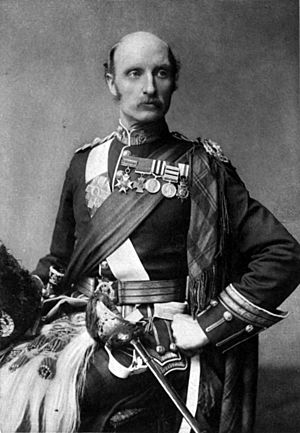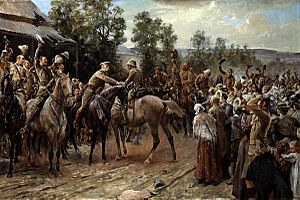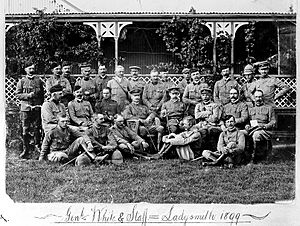George White (British Army officer) facts for kids
Quick facts for kids
Sir George Stuart White
|
|
|---|---|

Sir George Stuart White
|
|
| Born | 6 July 1835 Low Rock Castle, Portstewart, Ireland |
| Died | 24 June 1912 (aged 76) Royal Hospital Chelsea, London, England |
| Buried |
Broughshane Presbyterian Churchyard, County Antrim
|
| Allegiance | United Kingdom |
| Service/ |
British Army |
| Years of service | 1851–1905 |
| Rank | Field Marshal |
| Commands held | Commander-in-Chief, India Quetta District Upper Burma Field Force 2nd Brigade 2nd Battalion Gordon Highlanders |
| Battles/wars | Indian Mutiny Second Anglo-Afghan War Third Anglo-Burmese War Mahdist War Second Boer War |
| Awards | Victoria Cross Knight Grand Cross of the Order of the Bath Member of the Order of Merit Knight Grand Commander of the Order of the Star of India Knight Grand Cross of the Order of St Michael and St George Knight Grand Commander of the Order of the Indian Empire Knight Grand Cross of the Royal Victorian Order |
| Other work | Governor of Gibraltar Governor of Royal Hospital Chelsea |
Sir George Stuart White (born 6 July 1835 – died 24 June 1912) was a very important officer in the British Army. He became a Field Marshal, which is the highest rank in the army.
He was in Peshawar during the Indian Mutiny in 1857. Later, he fought bravely in the Second Anglo-Afghan War. He was even awarded the Victoria Cross for his amazing courage. This is the highest award for bravery in the British military.
Sir George White also led soldiers in the Third Anglo-Burmese War. He later became the commander of forces in Natal during the Second Boer War. He is famous for defending Ladysmith for many months during a difficult siege. After his military career, he served as the Governor of Gibraltar and then as the Governor of the Royal Hospital Chelsea.
Contents
Early Life and Military Start
George White was born in Low Rock Castle, Portstewart, which is in County Londonderry, Ireland. His father was James Robert White. George went to school at Bromsgrove School and King William's College. He then studied at the Royal Military College, Sandhurst, which is a famous army training school.
In 1853, he joined the army as an ensign in the 27th (Inniskilling) Regiment of Foot. This was the start of his long military career.
First Missions in India
In 1854, George White was sent to India. He was promoted to lieutenant in 1855. He was stationed in Peshawar during the Indian Mutiny. This was a major uprising against British rule in India.
He became a captain in 1863 and moved to the 92nd Regiment of Foot. After a few years in England, he returned to India with his regiment in 1868.
Fighting in Afghanistan
In 1875, he took command of his battalion. He fought in the Second Anglo-Afghan War. This war took place in Afghanistan. He was part of important battles like the Battle of Charasiab in 1879 and the Battle of Kandahar in 1880.
Awarded the Victoria Cross
Sir George White was 44 years old when he earned the Victoria Cross (VC). This happened because of his incredible bravery during the war in Afghanistan.
Here's why he received the award:
- At the Battle of Charasiab in October 1879, the enemy was on a strong hill. Their guns and rifles couldn't move them.
- Major White personally led an attack with two companies of his soldiers.
- They climbed up the steep hill. They found many enemy soldiers, about eight times their number.
- His men were tired, so Major White acted quickly. He took a rifle and went ahead by himself.
- He shot the enemy leader. This made the other enemy soldiers scared, and they ran away. His quick action helped win the position.
- Again, at the Battle of Kandahar in September 1880, Major White led the final charge.
- The enemy had a strong position and two cannons.
- He rode straight towards them, getting very close.
- He saw the cannons and bravely rushed forward to capture one. After this, the enemy retreated.
His Victoria Cross medal is now on display at the Gordon Highlanders Museum in Aberdeen, Scotland.
Later Military Career
After his bravery in Afghanistan, George White continued to rise in the army. He was promoted to lieutenant colonel in 1881. He also worked as a military secretary for the Governor-General of India.

In 1885, he was given command of a brigade (a large group of soldiers) in the Madras Army. He led this group during the Third Anglo-Burmese War in November 1885. He helped take control of Burma and was made a knight.
He became a major general in 1887. In 1889, he took command of the Quetta District. He led operations in the Zhob Valley and Balochistan. He was given more important awards, like the Knight Grand Commander of the Order of the Indian Empire.
Commander-in-Chief, India
In 1893, Sir George White became the Commander-in-Chief, India. This meant he was in charge of all British forces in India. He was promoted to lieutenant general and then to full general. He received even more honors, including the Knight Grand Cross of the Order of the Bath.
The Siege of Ladysmith
In 1899, Sir George White became the commander of forces in Natal at the start of the Second Boer War. He fought in the Battle of Elandslaagte. He then moved his troops to Ladysmith.
He took command of the soldiers defending Ladysmith during a long siege. General Sir Redvers Buller told him to give up the town. But Sir George White famously replied, "I hold Ladysmith for the Queen." He refused to surrender. He and his men held out for four more months. The town was finally rescued in February 1900.
After the siege, Sir George White's health was not good. He left Ladysmith to recover. For his service in the war, he received more high honors.
Later Life and Retirement
In 1900, Sir George White became the Governor of Gibraltar. This is an important role, overseeing the British territory. He was promoted to Field Marshal in 1903.
In 1905, he was appointed to a special group looking into army contracts. Later that year, he became a Member of the Order of Merit. From 1905 until his death in 1912, he was the Governor of the Royal Hospital Chelsea. This hospital cares for old soldiers.
Sir George White passed away on 24 June 1912. He was buried in Broughshane, a village in County Antrim, Northern Ireland. There is a statue of him in Portland Place, London. A band in Broughshane is still named after him today.
Family Life
In 1874, Sir George White married Amelia Maria Baly. They had one son and four daughters. Their son, Jack White, also served in the British Army. However, he later became an Irish republican and a socialist. He helped start the Irish Citizen Army, a group that worked for workers' rights and Irish independence.
Images for kids




